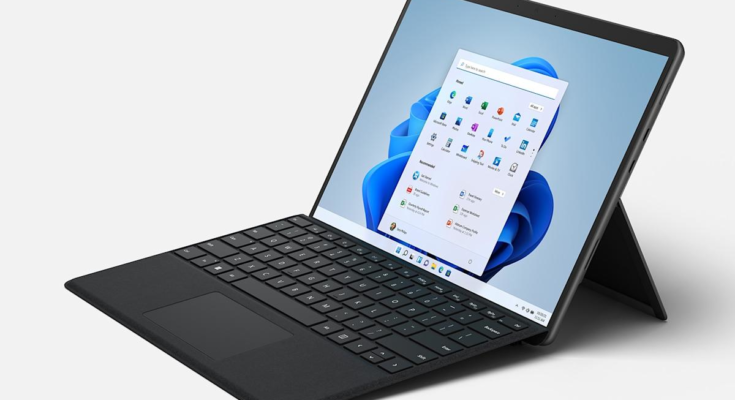Microsoft’s (MSFT) Surface Pro laptop-tablet hybrids are some of the best on the market. They combine excellent performance and portability with hardware that Microsoft purpose-built for Windows. And with the release of Windows 11 upon us, Microsoft is rolling out its latest Surface, the Surface Pro 8.
Starting at $1,099 and an extra $179 for a Surface Pro Signature Keyboard — Microsoft still doesn’t include a keyboard with the Surface Pro — the Pro 8 sports a redesigned look with significantly smaller bezels, and a larger 13-inch display.
But the Surface Pro 8 enters a market awash in top-notch 2-in-1 laptops, including the formidable Dell XPS 13 2-in-1. And then there’s Apple’s (AAPL) iPad Pro and MacBook Air, both of which are competitors to the Pro 8. And while Microsoft has made a wonderful device, its price isn’t exactly a steal.
A new look and better functionality
Microsoft’s Surface Pro line has kept the same look for quite some time. So it’s good to see that the Pro 8 gets a bigger 13-inch PixelSense display than the 12.3-inch panel found on the Surface Pro 7. The bezels on the Pro 8 are about as small as they can get, making the hybrid feel more like a modern PC.
Of course, the Surface’s signature kickstand is still out back and still lets you angle the 2-in-1 however you want, allowing you to lay the Pro 8 nearly flat for drawing and writing with the optional Surface Slim Pen 2. More on that later.
Behind the kickstand is the Surface Pro 8’s removable solid-state drive, though Microsoft says you’ll need to take it to an authorized technician to remove it. Making it, well, not exactly easy to remove.
This time around, Microsoft has added two USB C ports with Thunderbolt compatibility, meaning you can connect your Surface Pro 8 to an external doc, monitor, or even a desktop graphics card to do some serious gaming or video editing. There’s still a Surface connection port for charging, though you can also charge via a USB C charger, as well.
Power and performance
Inside, the Surface Pro 8 gets an 11-generation Intel (INTC) Core i5 or Core i7 processor. The Core i5 builds come with 8GB of RAM and between 128GB and 512GB of storage. There’s also an option to get 16GB of RAM, but you’ll only be able to get 256GB of storage with that.
Jump to the Core i7 option, and you can get 16GB of RAM and between 256GB and 1TB of storage. You can also go for broke and get a Core i7 with 32GB of RAM and 1TB of storage.
My review unit came with a Core i7, 16GB of RAM, and 128GB of storage, and I didn’t run into any slowdown. That said, this isn’t a machine that can run high-end games or do any significant video editing on its own. To do that, you’d need an external graphics card. Still, if you’re looking to browse the web, watch movies, and do some light gaming, the Surface Pro 8 is an easy sell.
The Surface Pro Signature Keyboard is the same style keyboard found on Microsoft’s Surface Pro X, which includes an indent for the Surface Slim Pen 2. The keys are easy to type on with a good amount of depth — though I wish the touchpad were a bit larger.
Microsoft says the Pro 8 can get up to 16 hours of battery life. That feels like a stretch, but you’ll certainly be able to get through the day with it. The Surface Pro 8 lasted throughout my own workday, which involved browsing the web, a few quick video chats, and writing this review.
The competition
Overall, the Surface Pro 8 is a top-notch 2-in-1. The shortfall? Its pricing. With a starting point of $1,099, the Pro 8 already has a premium price point. But that $1,099 doesn’t take into account the fact that the Pro 8 doesn’t include a keyboard. Add on a $179 Surface Pro Signature Keyboard, and you’re looking at a true starting price of $1,278.
That makes the Surface Pro 8 slightly more expensive than the Dell XPS 13 2-in-1, which gets an Intel Core i5 processor, 8GB of RAM, and 256GB of storage for $1,169. Apple’s MacBook Air, meanwhile, starts at $999 and gets that company’s custom M1 chip, 8GB of RAM, and 256GB of storage.
Then there’s the iPad Pro 12.9-inch, which features Apple’s M1 chip and 128GB of storage for $1,099. Add on a Magic Keyboard for $349, and you’re shelling out $1,448 for the setup. And while the iPad Pro is easily Apple’s most powerful tablet, and iPadOS and macOS could soon share apps, the Pro isn’t quite ready to function as a true laptop replacement just yet.
Should you get it?
I’ve been a fan of the Surface Pro line for years, and the Surface Pro 8 is no different.
Yes, it’s absolutely ridiculous that Microsoft doesn’t include a keyboard with it and lists the price as $1,099, when you need to drop an extra $179 on the Surface Pro Signature Keyboard.
Still, the benefits outweigh the cons here. The touchscreen is fantastic, the responsiveness is top notch, the ports are finally what you’d expect of a premium laptop, and it’s as portable as can be. Pricing is still hard to swallow considering you can get that XPS 13 2-in-1 with more storage for less than the Surface Pro 8. But if you’re looking for a laptop-tablet hybrid that’s powerful and portable, the Surface Pro 8 is hard to pass up.
Sign up for Yahoo Finance Tech newsletter
More from Dan
Follow Yahoo Finance on Twitter, Facebook, Instagram, Flipboard, LinkedIn, YouTube, and reddit
Got a tip? Email Daniel Howley at [email protected] over via encrypted mail at [email protected], and follow him on Twitter at @DanielHowley.



